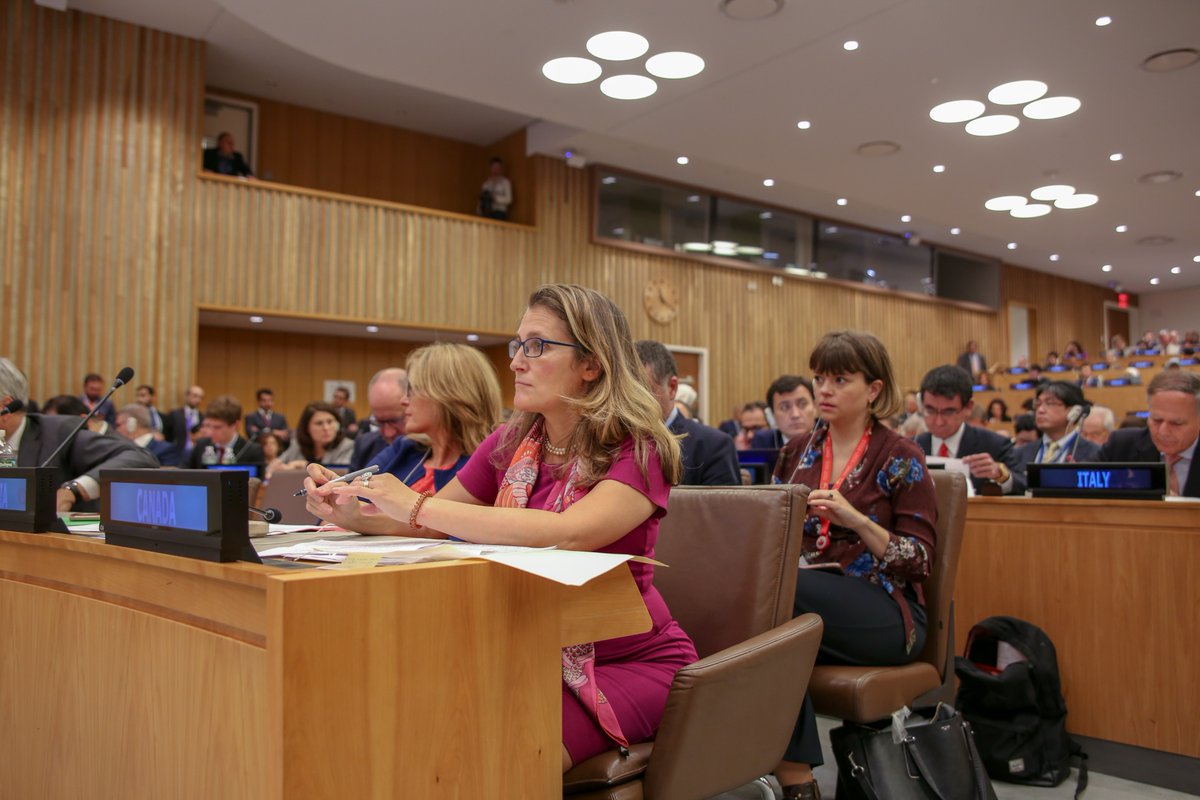
OTTAWA — Federal cabinet ministers were being called into a late-night NAFTA meeting Sunday with the prime minister amid signs that the fall finale to Canada’s long-running NAFTA drama may finally be at hand — with the famous unpredictability of the man in the White House giving everyone cause for caution.
Multiple sources told The Canadian Press the cabinet would meet around 10 p.m. at Justin Trudeau’s office across the street from Parliament Hill.
Foreign Affairs Minister Chrystia Freeland and U.S. Ambassador David MacNaughton had spent the day in Ottawa taking part in an aggressive, long-distance, last-minute push to get Canada into a trilateral free trade deal with the U.S. and Mexico on the eve of a key congressional deadline.
Central to the discussions Sunday has been an effort to secure some sort of assurances that will allow Canada to avoid the dreaded Section 232 tariffs on steel, aluminum and auto exports, which U.S. President Donald Trump has either threatened or already imposed on national security grounds.
Trade experts briefed on the progress so far say an agreement is well within reach.
“They’re moving towards closing the deal — it’s really not a question of if, it’s a question of when,” said Daniel Ujczo, an Ohio-based international trade lawyer at Dickinson Wright who represents large U.S. automakers and auto-parts manufacturers.
There’s just a lot going on, and not a lot of time to do it in…. at the end of the day, U.S. negotiators are agreeing, but it still has to be the president that signs off, and who knows where he is on things.”
Both Ujczo and Hassan Yussuff, the head of the Canadian Labour Congress and a member of the federal government’s NAFTA advisory council who was also briefed on the talks Sunday, say the question of how to deal with the 232 tariffs remains the central issue.
Ujczo said while Canada would rather have tariff protection spelled out when the deal is announced, he expects that as a compromise, all three countries will say they plan to meet again in the near future to hammer out the details of a detente on the 232 threat.
“The middle-ground approach looks like when they announce the deal, that the three parties will be meeting at such-and-such a date in the immediate future to resolve the steel and aluminum tariffs,” he said. “I think that’s what that will look like.”
Trump, who has already imposed tariffs on Canadian steel and aluminum, has also repeatedly threatened to impose even more crippling levies on auto imports if a deal can’t get done.
Ultimately, Ujczo said he expects Canada and the U.S. to reach a so-called “side letter” to the main deal that would resemble a similar agreement reached last month between Mexico and the U.S. which preserves duty-free access to the U.S. market for vehicles that comply with the agreement’s rules of origin.
Those rules require that a certain percentage of an imported vehicle’s components be manufactured in the United States.
Some have characterized the side letter as effectively establishing a quota on the number of autos that can be exported to the U.S. — anathema to the very principles of free trade. But Ujczo said it would only apply to a very small percentage of vehicles that don’t comply with the origin rules.
“When people are saying there’s a cap on auto exports, it’s only in the limited situation where the goods are non-conforming with the rules of origin. So if you comply with the rules of origin, there’s no way you are subject to 232 tariffs,” he said.
“This objection is largely more philosophical than practical — the idea of having quotas as a side letter to a free trade agreement. The practical consequences are limited, if any.”
Ujczo said the two sides have also largely settled on a dispute-resolution mechanism similar to that in the original NAFTA known as Chapter 19 — an issue that has long been a major stumbling block in the talks — and on a higher duty-free threshold for goods shipped into Canada: $100, up from $20.
Despite the fact it’s one of Trump’s favourite talking points, the politically sensitive question of greater U.S. access to Canada’s dairy market is also no longer a hurdle, say sources familiar with the talks.
Yussuff was summoned to Washington on Sunday to be briefed on the progress to date.
“232 is where the focus is,” he said. “They’ve been spending quite a lot of time trying to figure that out.”
Even Trudeau has been pulled into the fray: on what’s usually a personal day for the prime minister, his itinerary said he’d be spending Sunday in “private meetings” and he was seen entering his office early Sunday evening.
Chapter 19 and the 232 tariffs had emerged in recent days as the two biggest challenges in front of negotiators. And the clock is ticking: the U.S. Congress imposed a Sunday night deadline in an effort to get a deal voted on before Mexico swears in a new government.
“A persistent threat of tariffs is “highly unusual in a trading relationship,” Yussuff said.
“People are working hard on the Canadian side, and I’m optimistic we’ll get there, but as you know, these things are complicated. The deadline might get extended, who knows?”
Government officials in Ottawa, meanwhile, were playing down reports that a deal is imminent.
The government “is still having constructive discussions” with U.S. counterparts, and “some” progress has been made, said one insider, speaking on condition of anonymity given the sensitive nature of the talks.
“Our focus remains on the substance of the issues, not on timelines, and of course on getting a good deal for Canadians.”